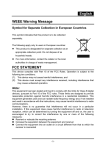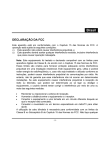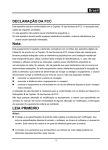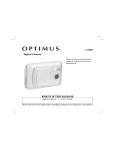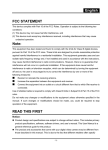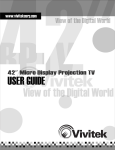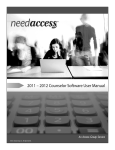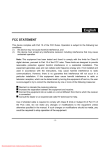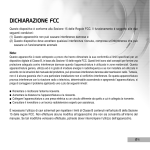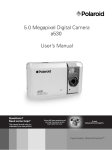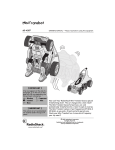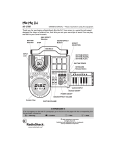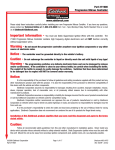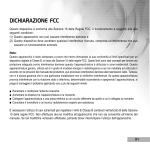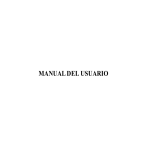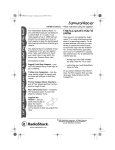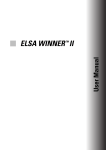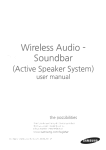Download Digital Video Camera WHAT·S IN THIS PACKAGE
Transcript
'LJLWDO9LGHR&DPHUD 7KDQN\RXIRUSXUFKDVLQJWKLV 2SWLPXV'LJLWDO9LGHR&DPHUD IURP5DGLR6KDFN :+$7·6,17+,63$&.$*( 'LJLWDO9LGHR&DPHUD8VHU·V*XLGH 3OHDVHUHDGWKLVXVHU·VJXLGHEHIRUHLQVWDOOLQJVHWWLQJXSDQGXVLQJ\RXUQHZSURGXFW 7KH)&&:DQWV<RXWR.QRZ 7KLVHTXLSPHQWKDVEHHQWHVWHGDQGIRXQGWRFRPSO\ZLWKWKHOLPLWVIRUD&ODVV%GLJLWDOGHYLFHSXUVXDQWWR3DUWRIWKH)&&5XOHV7KHVH OLPLWVDUHGHVLJQHGWRSURYLGHUHDVRQDEOHSURWHFWLRQDJDLQVWKDUPIXOLQWHUIHUHQFHLQDUHVLGHQWLDOLQVWDOODWLRQ7KLVHTXLSPHQWJHQHUDWHVXVHV DQGFDQUDGLDWHUDGLRIUHTXHQF\HQHUJ\DQGLIQRWLQVWDOOHGDQGXVHGLQDFFRUGDQFHZLWKWKHLQVWUXFWLRQVPD\FDXVHKDUPIXOLQWHUIHUHQFHWR UDGLRFRPPXQLFDWLRQV+RZHYHUWKHUHLVQRJXDUDQWHHWKDWLQWHUIHUHQFHZLOOQRWRFFXULQDSDUWLFXODULQVWDOODWLRQ,IWKLVHTXLSPHQWGRHVFDXVH KDUPIXOLQWHUIHUHQFHWRUDGLRRUWHOHYLVLRQUHFHSWLRQZKLFKFDQEHGHWHUPLQHGE\WXUQLQJWKHHTXLSPHQWRIIDQGRQWKHXVHULVHQFRXUDJHG WRWU\WRFRUUHFWWKHLQWHUIHUHQFHE\RQHRUPRUHRIWKHIROORZLQJPHDVXUHV 5HRULHQWRUUHORFDWHWKHUHFHLYLQJDQWHQQD ,QFUHDVHWKHVHSDUDWLRQEHWZHHQWKHHTXLSPHQWDQGUHFHLYHU &RQQHFWWKHHTXLSPHQWLQWRDQRXWOHWRQDFLUFXLWGLIIHUHQWIURPWKDWWRZKLFKWKHUHFHLYHULVFRQQHFWHG &RQVXOW\RXUORFDO5DGLR6KDFNVWRUHRUDQH[SHULHQFHGUDGLR79WHFKQLFLDQIRUKHOS,I\RXFDQQRWHOLPLQDWHWKHLQWHUIHUHQFHWKH)&&UHTXLUHV WKDW\RXVWRSXVLQJ\RXUSURGXFW&KDQJHVRUPRGL¿FDWLRQVQRWH[SUHVVO\DSSURYHGE\5DGLR6KDFNPD\FDXVHLQWHUIHUHQFHDQGYRLGWKHXVHU¶V DXWKRULW\WRRSHUDWHWKHHTXLSPHQW )&&'HFODUDWLRQRI&RQIRUPLW\ 7KLVGHYLFHFRPSOLHVZLWK3DUWRIWKH)&&5XOHV2SHUDWLRQLVVXEMHFWWRWKHIROORZLQJWZRFRQGLWLRQV7KLVGHYLFHPD\QRWFDXVHKDUPIXO LQWHUIHUHQFHDQG7KLVGHYLFHPXVWDFFHSWDQ\LQWHUIHUHQFHUHFHLYHGLQFOXGLQJLQWHUIHUHQFHWKDWPD\FDXVHXQGHVLUHGRSHUDWLRQ 3URGXFW 'LJLWDO&DPHUD 0RGHO 45 5DGLR6KDFN 5HVSRQVLEOH 5DGLR6KDFN&LUFOH 3DUW\ )RUW:RUWK7; READ THIS FIRST Trademark Information Microsoft® and Windows® are U.S. registered trademarks of Microsoft Corporation. Pentium® is a registered trademark of Intel Corporation. SDTM is a trademark. Other names and products may be trademarks or registered trademarks of their respective owners. Product Information Product design and specifications are subject to change without notice. This includes primary product specifications, software, software drivers, and user’s manual. This User Manual is a general reference guide for the product. The product and accessories that come with your digital video camera may be different from those described in this manual. This is due to the fact that different retailers often specify slightly different product inclusions and accessories to suit their market requirements, customer demographics, and geographical preferences. Products very often vary between retailers especially with accessories such as batteries, chargers, memory cards, cables, carrying cases/pouches, and language support. Occasionally a retailer will specify a unique product color, appearance, and internal memory capacity. Contact your dealer for precise product definition and included accessories. The illustrations in this manual are for the purpose of explanation and may differ from the actual design of your digital video camera. The manufacturer assumes no liability for any errors or discrepancies in this user manual. For user manual and driver updates, refer to our website or contact your dealer. EN-2 SAFETY INSTRUCTIONS Read and understand all Warnings and Cautions before using this product. Warnings If foreign objects or water have entered the camera, turn the power OFF and remove the batteries. Continued use in this state might cause fire or electric shock. Consult the store of purchase. If the camera has fallen or its case has been damaged, turn the power OFF and remove the batteries. Continued use in this state might cause fire or electric shock. Consult the store of purchase. Do not disassemble, change or repair the camera. This might cause fire or electric shock. For repair or internal inspection, ask the store of purchase. Do not use the camera in areas near water. This might cause fire or electric shock. Take special care during rain, snow, on the beach, or near the shore. Do not place the camera on inclined or unstable surfaces. This might cause the camera to fall or tilt over, causing injury. Keep the batteries out of the reach of children. Swallowing batteries might cause poisoning. If the battery is accidentally swallowed, immediately consult a physician. Do not use the camera while you are walking, driving or riding a motorcycle. This might cause you to fall over or result in a traffic accident. EN-3 Cautions Insert the batteries paying careful attention to the polarity (+ or –) of the terminals. Inserting the batteries with its polarities inverted might cause fire and injury, or damage to the surrounding areas due to the battery rupturing or leaking. Do not fire the flash close to anyone’s eyes. This might cause damage to the person’s eyesight. Do not subject the LCD monitor to impact. This might damage the glass on the screen or cause the internal fluid to leak. If the internal fluid enters your eyes or comes into contact with your body or clothes, rinse with fresh water. If the internal fluid has entered your eyes, consult a physician to receive treatment. A camera is a precision instrument. Do not drop it, strike it or use excessive force when handling the camera. This might cause damage to the camera. Do not use the camera in humid, steamy, smoky, or dusty places. This might cause fire or electric shock. Do not remove the battery immediately after a long period of continuous use. The battery becomes hot during use. Touching a hot battery might cause burns. Do not wrap the camera or place it in cloth or blankets. This might cause heat to build up and deform the case, resulting in fire. Use the camera in a wellventilated place. Do not leave the camera in places where the temperature may rise significantly, such as inside a car. This might adversely affect the case or the parts inside, resulting in fire. Before you move the camera, disconnect cords and cables. Failure to do this might damage cords and cables, resulting in fire and electric shock. EN-4 Notes on Battery Usage When you use the battery, carefully read and strictly observe the Safety Instructions and the notes described below: Different battery types and surrounding temperatures may affect the battery performance. Avoid using batteries in extremely cold environments as low temperatures can shorten the battery life and reduce camera performance. This low temperature will also influence Alkaline battery performance, therefore Ni-MH rechargeable battery is highly recommended. If you are using the new rechargeable batteries or rechargeable batteries that have not been used for an extended period of time (batteries that pass the expiration date are exceptions) might affect the number of pictures that can be taken. Therefore, to maximize their performance and lifetime, we recommend you fully charge the batteries and discharge them for at least one complete cycle before use. The battery may feel warm when using the camera for an extended period of time or using the flash continuously. This is normal and not a malfunction. The camera may feel warm when being used continuously or for an extended period of time. This is normal and not a malfunction. If you will not be using the batteries for an extended period of time, remove them from the camera to prevent leakage or corrosion. Never use batteries of different types (together) or mix old and new batteries. Always keep the terminals in a clean state. Never use manganese batteries. EN-5 CONTENTS INTRODUCTION..................................................8 PHOTOGRAPHY MODES.................................. 23 Package Contents........................................ 9 Capturing Still Images.................................. 23 GETTING TO KNOW YOUR DIGITAL VIDEO Recording Video Clips.................................. 24 CAMERA ...........................................................10 Macro Mode................................................. 24 Front View................................................... 10 Rear View.................................................... 11 LCD Monitor Information............................... 12 Normal Mode................................................25 Zoom Photography...................................... 25 Setting the Flash.......................................... 26 Setting the Self-Timer................................... 27 GETTING STARTED.......................................... 16 PLAYBACK MODE.............................................28 Installing the Batteries (Optional Accessory)..16 Playing Back Still Images/Video Clips..........28 Turning the Power On/Off...........................16 Playing Back Still Images/Video Clips on Attaching the Strap.....................................17 TV...............................................................29 LED Indicators.............................................17 Zoom Playback.............................................30 Loading an SD Memory Card Thumbnail Display........................................30 (Optional Accessory).....................................18 Protecting Still Images/Video Clips...............31 Using the LCD Panel.................................. 19 Slide Show Display.......................................32 Choosing the OSD (On-Screen Display) Deleting Still Images/Video Clips..................33 Language....................................................20 Setting the Date and Time..........................20 Formatting an SD Memory Card................... 21 Setting Image Resolution and Quality......... 22 EN-6 MP3 MODE.........................................................34 INSTALLING VIDEOSTUDIO................................50 AUDIO RECORDING MODE...............................35 USING THE DIGITAL VIDEO CAMERA AS A PC Recording Audio Files..................................35 CAMERA.............................................................51 Playing Back Audio Files.............................35 Step 1: Install the PC camera driver...............52 Deleting MP3 / Audio Files.........................36 Step 2: Connect the digital video camera to MENU OPTIONS.................................................37 Movie Menu...............................................37 Capture Menu............................................39 your computer.......................................53 Step 3: Run your application software(i.e. Windows NetMeeting).......................53 Playback Menu...........................................42 CONNECTING THE DIGITAL VIDEO CAMERA TO MP3 / Audio Menu......................................43 OTHER DEVICES.................................................54 System Menu.............................................44 TRANSFERRING RECORDED FILES TO YOUR COMPUTER........................................................47 SPECIFICATIONS...............................................55 APPENDIX............................................................56 Step 1: Install the USB driver (Windows 98 users only).......................................47 Step 2: Connect the digital video camera to your computer................................48 Step 3: Download still images, video clips and audio files........................................49 EN-7 INTRODUCTION Thank you for purchasing the new digital video camera! This digital video camera is designed as an “entry-level” handy cam. Equipped with a 3.0 Megapixels CMOS sensor, your camera delivers good quality, 2048 x 1536 resolution images. Other features provided by the digital video camera include the following: Support for SD memory card for memory 3.0 Megapixels expansion A high-resolution CMOS sensor provides 3.0 You may wish to expand the memory capacity megapixels for good quality images. (up to 512MB capacity) by using an external Auto flash memory card. An auto flash sensor automatically detects USB connection (USB 2.0 compliant) the shooting (lightening) conditions and Still images, video clips, or audio recording files determines whether the flash should be that you have recorded can be downloaded to used. your computer using the USB cable (A USB driver 2.0” LTPS color image LCD monitor is required for Win 98 and Win98SE). Digital zoom: 1x~8x Multi functionality 32MB internal (built-in) memory (24MB In addition to still image and video, your digital available for image storage) video camera can act as a voice recorder, MP3 Images can be captured without using a player and PC camera. memory card. Provided editing software: VideoStudio You can enhance and retouch your images on your computer by using the provided editing software. EN-8 Package Contents Carefully unpack your kit box and ensure that you have the following items. In the event that any item is missing or if you find any mismatch or damage, promptly contact your dealer. Common product components: Digital video camera User’s Guide USB Cable Software CD-ROM Tripod AV Cable Earphone Camera Strap Camera Pouch Common (optional) accessories: SD memory card Batteries Accessories and components may vary by retailer. EN-9 GETTING TO KNOW YOUR DIGITAL VIDEO CAMERA Front View 1. Lens 2. Microphone 3. Flash 4. Self-timer LED 5. Tripod socket 6. Focus switch Macro mode Normal mode 7. SD card cover 8. Battery cover EN-10 Rear View 1. Power button 2. button 3. Zoom lever Record button T/ Zoom in W/ Zoom out 4. State LED indicator 5. Image button 6. Earphone connector 7. A/V terminal 8. USB connector 9. Strap holder 10. Speaker 11. LCD panel / monitor 12. Menu button 13. Right / Fast forward button Self-timer button 14. Left / Rewind button Flash button EN-11 LCD Monitor Information Movie Mode: 10 9 8 7 00:00:28 1 2 6 5 3 4 1. Movie mode icon SD memory card is full 8. Video quality 2. Zoom status 5. Macro mode SUPER FINE 3. Battery power indicator 6. EV compensation FINE Full battery power Medium battery power AUTO AUTO Low battery power DAYLIGHT Virtually no battery power LAMP 4. SD memory card indicator EN-12 7. White balance FLUORESCENT-1 NORMAL 9. Video resolution 640 x 480 pixels 320 x 240 pixels 10.Available recording time An SD memory card is loaded FLUORESCENT-2 (Before recording)/ No SD memory card is loaded SHADE Elapsed time (While recording) Camera Mode: 13 12 1 11 10 9 2 8 7 3 6 1. Still image mode icon 5 4 8. ISO sensitivity 12.Image resolution 2. Zoom status AUTO 2880 x 2160 3. Battery power indicator 100 4. SD memory card indicator 200 5. Available number of shots 400 2592 x 1944 2048 x 1536 1280 x 960 640 x 480 6. Flash mode Flash off A Auto flash 9. EV compensation 10.AWB (White balance) 11.Image quality Auto flash with SUPER FINE red-eye reduction FINE 7. Macro mode 1.2M 13.Self-timer indicator (if used) 3-second delay 10-second delay NORMAL EN-13 Audio Recording Mode 1. 2. 3. 4. 5. Audio recording mode Remaining battery status SD memory card indicator (if present) Recording indicator Available recording time (Before recording)/ Elapsed time (While recording) 1 Video (Movie) Playback 1. Folder and file name 100-0004 2. Duration of current video 2 00:01:22 3 (Before playback)/ Elapsed time (During playback) 3. Video playback mode icon 4 4. Battery power indicator 5. SD memory card indicator Before playback 6. Playback indicator 7. Video status bar 6 00:01:22 8. Sound level (speaker volume) Low volume Mild volume Medium volume High volume Full volume Mute (no sound) EN-14 7 8 During playback 5 4 Still Image Playback Still-image playback mode 1. 1 100-0005 2. Battery power indicator 3. SD memory card indicator 4. Folder and file name 2 3 Audio / MP3 Playback 1. / 7 8 9 Audio/MP3 playback mode icon 10 00:01:22 1 2. File name 3. Battery power indicator 2 AUD_0001 4. SD memory card indicator 5. Audio/MP3 status bar 3 6. Sound level (speaker volume) 7. Playback indicator 6 5 4 8. Play mode indicator 9. Play one file Play all files Play the selected files Repeat indicator 10.Elapsed time EN-15 GETTING STARTED Installing the Batteries (Optional Accessory) You can use 2 AA size batteries to power the digital video camera. 1. Slide the battery cover. 2. Insert the batteries, noting correct polarity (+ or -). 3. Close the battery cover firmly. Turning the Power On/Off Press and hold the button until the digital video camera turns on. To turn the power off, press and hold the button again. EN-16 Attaching the Hand Strap Attach the strap as shown in the illustration. LED Indicators Indicator LED indicator LED indicator LED indicator Self-timer indicator State Solid green Description/Activity 1. The digital video camera is powering up. 2. The digital video camera is ready to record images (or movies). Blinking green USB communication/transfer in progress. Blinking red Charging the flash. Blinking red The self-timer function is activated. EN-17 Loading an SD Memory Card (Optional Accessory) The digital video camera comes with 32MB of internal memory (24MB available for image storage), allowing you to record video clips, captured still images, MP3 and audio files in the digital video camera. However, you can also expand the memory capacity by using an optional SD (Secure Digital) memory card so that you can store more files. 1. Open the SD memory card cover. 2. Inset the SD memory card. If the card cannot be inserted, check the orientation. 3. Close the SD card cover firmly. To remove the SD memory card, make sure the camera is turned off. Open the SD card cover, then press lightly on the edge of the memory card and it will eject. Be sure to format an SD memory card with this digital video camera before using it. Refer to section in the manual titled “Formatting an SD memory card” for further details. To prevent valuable data from being accidentally erased from an SD card, you can slide the write protect tab (on the side of the SD memory card) to “LOCK”. To save, edit, or erase data on an SD memory card, you must unlock the card. EN-18 Using the LCD Panel 1. Open the panel by pulling it away from the digital video camera. 2. Choose the angle of the monitor that suits you best by rotating the panel. Make sure you open the LCD panel at 90 degrees before attempting to rotate it. Rotate the LCD panel carefully and with the correct direction, over rotation and rotation in the wrong direction may damage the hinge that connects the LCD monitor to the digital video camera. Avoid contact with the LCD monitor when moving the LCD panel. Do not hold the digital video camera by the LCD panel. EN-19 Choosing the OSD (On-Screen Display) Language Specify in which language menus and messages are to be displayed on the LCD monitor for the first time. Select the displayed language with the button. The setting will be stored. Refer to the zoom lever and press the section in this manual titled "LANGUAGE" in the System Menu for further details. The OSD language setting screen appears and prompts you to choose a language for displayed information on the LCD monitor only when you first turn the digital video camera on. It will not appear again the next time when you power on it. Setting the Date and Time The date/time setting screen will automatically appear: When first turning the digital video camera on; When turning the power on after the digital video camera has not had batteries inserted for an extended period of time. To adjust the date and time: 1. Select the year, month, day and time fields with the / buttons. 2. Press the button after all fields are set. To increase a value, slide the zoom lever to the / T side. To decrease a value, slide the zoom lever to the / W side. The time is displayed in 24-hours format. EN-20 Formatting an SD Memory Card Format an SD memory card before its initial usage. button. 1. Turn on the power by pressing and holding the 2. Toggle the button to select movie, camera or playback (SELECT MODE) mode. Then press the button. The MOVIE / CAPTURE / PLAYBACK / MP3 / AUDIO MENU is displayed. 3. Press to access the SYSTEM MENU. 4. Select [FORMAT] with the zoom lever, and press the button. 5. Select [YES] with the zoom lever, and press the button. FORMAT Formatting an SD memory card erases all data and file types from the card, including photos, video and audio. Formatting is an irreversible action and data cannot be recovered at a later time. An SD memory card having any problem cannot be properly formatted. EN-21 Setting Image Resolution and Quality As you get to know the digital video camera, you can set the image resolution (number of vertical and horizontal pixels) and image quality (compression ratio) based on the types of images you want to shoot. These settings affect the number of images that can be stored in memory, or on a memory card. Higher resolution and higher quality images provide finer detail but enlarges the file size of images. To change the image resolution or image quality, perform these steps below: button. 1. Turn on the power by pressing and holding the 2. Toggle the button to access in camera or movie mode. Then press button. the The CAPTURE / MOVIE MENU is displayed. 3. Select [SIZE] with the zoom lever, and press the button. 4. Select the desired setting with the zoom lever, and press the button. 5. Repeat steps 3 and 4 to set the [QUALITY]. MOVIE MENU CAPTURE MENU The possible number of shots and recording time depend on the storage size, resolution and quality settings and the subject of the image to be captured. EN-22 PHOTOGRAPHY MODES Capturing Still Images 1. Turn on the power by pressing and holding the button. 2. Compose the shot. button to capture a still image. 3. Press the The actual captured image appears to be larger than the one on the LCD preview after it was captured. Number of recordable images The frame counter indicates the approximate number of images that can be stored on the internal memory or the SD memory card. The number of recordable images may vary depending on the recorded subject, the capacity of the memory card, the types of information stored (still, motion, audio), and how much information is stored before changing the picture quality or resolution. Resolution Quality Compression ratio 32MB internal memory 2880 x 2160 pixels 2592 x 1944 pixels 2048 x 1536 pixels 1280 x 960 pixels 1.2M 640 x 480 pixels SUPER FINE FINE NORMAL SUPER FINE FINE NORMAL SUPER FINE FINE NORMAL SUPER FINE FINE NORMAL SUPER FINE FINE NORMAL 4:1 8:1 12:1 4:1 8:1 12:1 4:1 8:1 12:1 4:1 8:1 12:1 4:1 8:1 12:1 (24MB available for image storage) 6 12 19 7 15 23 12 25 37 32 63 93 122 226 264 The above data show the standard testing results. The actual capacity varies according to the shooting conditions and settings. EN-23 Recording Video Clips 1. Turn on the power by pressing and holding the button. 2. Compose the shot. button. 3. Press the The recording of the video clip will start. Pressing the button again will pause the recording. Pressing the recording. 4. Press the button to stop recording. button during pause will resume Macro Mode Select this when you want to take close-up photography. 1. 2. 3. 4. Turn on the power by pressing and holding the button. side. Slide the focus switch to the Compose the shot. Press the button to capture a still image. To record video clips, press the button to start recording, and button to end the recording. then press the After a macro shot is taken DO NOT FORGET to reset the lens to the normal position. Flash mode is automatically set to off once you switch to Macro mode. EN-24 Normal Mode This mode is suitable for scenery and portrait shooting. 1. 2. 3. 4. Turn on the power by pressing and holding the button. Slide the focus switch to the side. Compose the shot. Press the button to capture a still image. To record video clips, press the button to start recording, and then press the button to end the recording. Zoom Photography Zoom photography allows you to capture telephoto and wide-angle shots. 1. Turn on the power by pressing and holding the button. 2. Compose the shot with the zoom lever. The subject appears closer by sliding the zoom lever to the /T side. The subject appears farther away by sliding the zoom lever to the / W side. 3. Press the button to capture a “zoomed” image. To record video clips, press the button to start recording, and then press the button to end the recording. You can also use the zoom lever to zoom in on or zoom out from the subject while recording the video clips. EN-25 Setting the Flash Set the flash to suit the photographic conditions. button. 1. Turn on the power by pressing and holding the 2. Press the ( ) button to select the desired flash mode. The table below will help you choose the appropriate flash mode: Flash Mode Flash off A Description Use this mode when taking pictures using indoor lighting, for stages and indoor competitions, and when the subject is too far away for the flash to be effective. Auto flash The flash fires automatically to suit the photographic conditions. Auto flash with Use this mode to reduce the red-eye phenomenon when you want to take natural- red-eye reduction looking photographs of people and animals in low-light conditions. When taking photographs, the red-eye phenomenon can be reduced by asking the subject (person) to look at the digital video camera or get as close to the digital video camera as possible. The flash cannot be set in the movie mode. EN-26 Setting the Self-Timer This setting allows still images to be captured with the self-timer. 1. 2. 3. 4. Turn on the power by pressing and holding the button. Press the ( ) button to select the setting. Compose the shot. Press the button. The self-timer LED and self-timer icon flash, and then the image is captured after the preset time has elapsed. To cancel the self-timer during operation, press again the ( ) button. Once the self-timer has been activated and the button has been pressed, you can not slide the zoom lever. The table below will help you choose the appropriate self-timer mode: Self-timer mode Description The picture is taken about 3 seconds after the 3 sec. The picture is taken about 10 seconds after the 10 sec. button is pressed. button is pressed. Self-timer cannot be set in the movie mode. The self-timer setting is automatically cancelled after an image is captured. EN-27 PLAYBACK MODE Playing Back Still Images/ Video Clips You can playback the still images on an LCD monitor. 1. Turn on the power by pressing and holding the 2. Toggle the button to go to [SELECT MODE]. button. 3. Select [IMAGE/MOVIE] with the zoom lever and press the button. The last image/video clip appears on the LCD monitor. 4. Select the desired images with the zoom lever. To view the previous image, slide the zoom lever to the / T side. To view the next image, slide the zoom lever to the / W side. To start playing back the video clips, follow steps 1-4 above, and then press the button. A press of the / buttons during playback allows fast forward play / fast reverse play. To pause video playback, press the button; to cancel pause, press the button again. To stop video playback, press the button. This stops playback and returns to the start of the video clip. To playback the video clips on the computer, we recommend you use Windows Media Player 9.0 (WMP 9.0) or the Software Application we offered. You can download the WMP version from the website at www.microsoft.com. To adjust the sound level, sliding the zoom lever to the T / side will increase the volume; sliding the zoom lever to the W / side will decrease the volume. EN-28 Playing Back Still Images/Video Clips on TV You can also playback your images on a TV screen. Before connecting to any devices, make sure to select NTSC / PAL to match the video output system of the video equipment you are going to connect to the digital video camera. Then turn all connected devices off. 1. Connect one end of the A/V cable to the A/V terminal of the digital video camera. 2. Connect the other end to the A/V input socket of the TV set. 3. Turn the TV and digital video camera on. 4. Playback the still images / video clips. The method of operation is the same as playing back still images and video clips on the digital video camera. TV EN-29 Zoom Playback Images that are being played back can be enlarged. The zoom factor displayed on the screen shows the current magnification ratio. button. Turn on the power by pressing and holding the Toggle the button to go to [SELECT MODE]. Select [IMAGE/MOVIE] with the zoom lever and press the button. Select the desired images with the zoom lever. To view the previous image, slide the zoom lever to the / T side. To view the next image, slide the zoom lever to the / W side. 5. The displayed image can be enlarged by each press of the button. The magnification factors range from 1x to 8x (within 16 stages: 1.0x, 1.5x, 2.0x, 2.5x, 3.0x, 3.5x, 4.0x, 4.5x, 5.0x, 5.5x, 6.0x, 6.5x, 7.0x, 7. 5x, 8.0x and thumbnail display). During zoom playback, the outer frame indicates the entire image; while the inner frame indicates the location of the currently enlarged area. 6. Slide the zoom lever upward or downward or press the / buttons to select the area to enlarge. 1. 2. 3. 4. 100-0001 2.0X Thumbnail Display This function allows you to view 9 thumbnail images on the LCD monitor at the same time, so you can quickly search for the image that you want. 1. Follow "Zoom Playback" section steps 1-5 until the thumbnail display appears on the screen. 2. Press the / buttons to select the image/video clip to be displayed at regular size. button. 3. Press the 4. To see the next thumbnail page, highlight the last photo in the current thumbnail page and press . 100-0002 001 / 009 EN-30 Protecting Still Images/Video Clips Set the data to read-only to prevent images from being erased by mistake. 1. Turn on the power by pressing and holding the 2. Togge the button to go to [SELECT MODE]. button. button. 3. Select [IMAGE/MOVIE] with the zoom lever and press the 4. Select the still image/video clip that you want to protect with the zoom lever. You may select the still image/ video clip that you want to protect from the thumbnail display. 5. Press the button. The PLAYBACK MENU is displayed. 6. Select [PROTECT] with the zoom lever, and press the PLAYBACK MENU SLIDE SHOW 5 SEC DELETE FILE ONE FILE DELETE ALL ALL FILE PROTECT EXIT ONE FILE button. 7. Select [ONE FILE] or [ALL FILE] with the zoom lever, and press the button. 8. Select [LOCK] by pressing the / buttons, and pressing the button. Protect is executed and the digital video camera returns to the play mode. The protect icon is displayed with protected images. When [All FILE] are selected, is displayed with all the images. To cancel protection, repeat steps 5-8 to select [UNLOCK] by pressing the / buttons, and pressing the button. The removal of image protection is executed and the digital video camera returns to the play mode. LOCK UNLOCK 100-0002 EN-31 Slide Show Display The slideshow function enables you to play back still images/video clips automatically in order one image at a time. 1. Turn on the power by pressing and holding the button. 2. Toggle the button to go to [SELECT MODE]. PLAYBACK MENU 3. Select [IMAGE/MOVIE] with the zoom lever and press the 4. Press the button. The PLAYBACK MENU is displayed. button. 5. Select [SLIDE SHOW] with the zoom lever, and press the button. SLIDE SHOW 5 SEC DELETE FILE 7 SEC DELETE ALL 9 SEC PROTECT ONE FILE 6. Set the playback interval with the zoom lever, and press the button. The slide show starts. The video clips display the first frame image, but are not played back. To stop the slide show, press the button. You can adjust the slide show display interval within the range of 5 SEC, 7 SEC, and 9 SEC. EN-32 Deleting Still Images/Video Clips 1. Turn on the power by pressing and holding the 2. Toggle the button to go to [SELECT MODE]. button. PLAYBACK MENU 3. Select [IMAGE/MOVIE] with the zoom lever and press the button. 4. Select the still image/video clip that you want to erase with the zoom lever. You may select the still image/ video clip that you want to erase from the thumbnail display. 5. Press the button. The PLAYBACK MENU is displayed. 6. Select [DELETE FILE] or [DELETE ALL] with the zoom lever, and press button. the DELETE FILE: Delete the current still image/video clip. DELETE ALL: Delete all still images/video clips. 7. Select [YES] with the zoom lever, and press the button. SLIDE SHOW 5 SEC DELETE FILE YES DELETE ALL NO PROTECT ONE FILE PLAYBACK MENU SLIDE SHOW 5 SEC DELETE FILE NO DELETE ALL YES PROTECT NO To not delete, select [NO], and press the button. If all video clips/images are deleted, [NO FILE!] pops up. If you want to turn back to the photography mode, press the button. EN-33 MP3 MODE The digital video camera allows you to play back MP3 files. You may download MP3 files to your computer and then copy them into the digital video camera via the USB cable or insert an SD memory card with MP3 files recorded into the digital video camera. 1. Turn on the power by pressing and holding the button. 2. Toggle the button to go to [SELECT MODE]. 3. Select [MP3] with the zoom lever and press the button. The MP3 LIST appears on the screen. Button operations State BUTTON T/ W/ EN-34 MP3 Playlist Power off (press & hold) Scroll up Scroll down Previous page Next page Back to LCD preview Enter MP3 menu Select/Un-select Start to play MP3 music During playback Power off (press & hold) Volume + Volume N/A N/A N/A N/A Stop playing MP3 music Pause playing MP3 music SELECT MODE IMAGE / MOVIE MP3 AUDIO AUDIO RECORDING MODE The digital video camera enables you to record and play back audio files anytime and anywhere. Recording Audio Files 1. Turn on the power by pressing and holding the button. 2. Toggle the button to select audio recording mode as the illustration. 3. Press the button. Voice starts recording. To pause recording, press the button again. To stop recording, press the button. The maximum recordable time for voice recording exceeds 1 hour. Playing Back Audio Files SELECT MODE 1. Turn on the power by pressing and holding the button. 2. Toggle the button to go to [SELECT MODE]. 3. Select [AUDIO] with the zoom lever and press the button. The AUDIO LIST appears on the screen. IMAGE / MOVIE MP3 AUDIO Button operations Audio State Button T/ W/ Playlist Power off (press & hold) Scroll up Scroll down Previous page Next page Back to LCD preview Enter Voice menu Select/Un-select Start to play voice file During playback Power off (press & hold) Volume + Volume N/A N/A N/A N/A Stop playing audio file Pause playing audio file EN-35 Deleting MP3 / Audio Files 1. Turn on the power by pressing and holding the button. 2. Toggle the button to go to [SELECT MODE]. 3. Select [MP3] / [AUDIO] with the zoom lever and press the button. The MP3 / AUDIO LIST appears on the screen. 4. Press the button. The MP3 / AUDIO MENU appears on the screen. 5. Select [DELETE] with the zoom lever and press the button. SELECT: Delete the selected audio or MP3 file. ALL: Delete all audio or MP3 files in a single operation. / 6. Use to select [YES], and press the button. To not delete, select [NO], and press the button. If all files are deleted, [NO FILE!] pops up. If you want to turn back to the photography mode, press the MP3 MENU button. SELECT YES EN-36 NO MENU OPTIONS Movie Menu This menu is for the basic settings to be used when capturing video clips in the photography mode. 1. Turn on the power by pressing and holding the button. 2. Press the button. The MOVIE MENU is displayed on the screen. 3. Select the desired option item with the zoom lever, and press the button. 4. Select the desired setting with the zoom lever, and press the button. 5. To exit from the menu, press the button. MOVIE MENU SIZE This sets the size of the still image that will be captured. : 640 X 480 : 320 X 240 QUALITY This sets the quality (compression rate) at which the still image is captured. : : : SUPER FINE FINE NORMAL EN-37 EV Your digital video camera adjusts the exposure of each scene automatically. However, if the subject is very dark, or very bright, you may override the digital video camera's automatic exposure determination to make the subject brighter or darker. This is called EV compensation. The EV compensation can be adjusted from -1.8EV to +1.8EV. AWB This sets the white balance under a variety of lighting conditions and permits photographs to be taken that approach the conditions that are seen by the human eye. [AUTO] [ ] [ ] [ ] [ ] [ ] EN-38 AUTO: Automatic adjustment DAYLIGHT: For recording outdoors on a bright day LAMP: For recording under lamp light FLUORESCENT-1: Cool white fluorescent (W3900-4500K) FLUORESCENT-2: Day white fluorescent (W4600-5400K) SHADE: For recording outdoors on a cloudy day Capture Menu This menu is for the basic settings to be used when capturing still images in the photography mode. 1. Turn on the power by pressing and holding the button. button to access in camera mode. Then press the 2. Toggle the button. The CAPTURE MENU is displayed on the screen. 3. Select the desired option item with the zoom lever, and press the button. 4. Select the desired setting with the zoom lever, and press the button. 5. To exit from the menu, press the button. SIZE This sets the size of the still image that will be captured. 2880 x 2160 : : : : 1.2M CAPTURE MENU CAPTURE MENU DATE PRINT NO 2592 x 1944 2048 x 1536 1280 x 960 640 x 480 QUALITY This sets the quality (compression rate) at which the still image is captured. : : : SUPER FINE FINE NORMAL EN-39 EV Your digital video camera adjusts the exposure of each scene automatically. However, if the subject is very dark, or very bright, you may override the digital video camera's automatic exposure determination to make the subject brighter or darker. This is called EV compensation. The EV compensation can be adjusted from -1.8EV to +1.8EV. Examples of Exposure Compensation + (positive) compensation * Printed matter comprising black text on light-colored paper * Backlighting * Bright scenes or strong reflected light such as ski slopes * When the sky accounts for a large area on the screen - (negative) compensation * People illuminated by a spotlight, in particular, against dark background * Printed matter comprising white text on dark-colored paper * Weak reflecting surfaces such as evergreen trees or darkish leaves AWB This sets the white balance under a variety of lighting conditions and permits photographs to be taken that approach the conditions that are seen by the human eye. [AUTO] AUTO: Automatic adjustment [ ] DAYLIGHT: For recording outdoors on a bright day [ ] LAMP: For recording under lamp light [ ] FLUORESCENT-1: Cool white fluorescent (W3900-4500K) [ ] FLUORESCENT-2: Day white fluorescent (W4600-5400K) [ ] SHADE: For recording outdoors on a cloudy day EN-40 ISO This sets the sensitivity for photography. When the sensitivity is raised (and the ISO figure is increased), photography will become possible even in dark locations, but the more pixilated (grainer) the image will appear. [AUTO]: Auto adjustment [100]: Equivalent to ISO100 [200]: Equivalent to ISO200 [400]: Equivalent to ISO400 DATE PRINT The capture date can be printed directly on your still images. This function must be activated before the image is captured. [YES]: Imprints the date on the still images when capturing images. [NO]: Does not imprint the date on the still images when capturing images. EN-41 Playback Menu This menu sets which settings are to be used for playback. 1. 2. 3. 4. Turn on the power by pressing and holding the button. Toggle the button to go to [SELECT MODE]. button. Select [IMAGE/MOVIE] with the zoom lever and press the Press the button. The PLAYBACK MENU is displayed on the screen. 5. Select the desired option item with the zoom lever, and press the button. 6. Select the desired setting with the zoom lever, and press the button. 7. To exit from the menu, press the button. PLAYBACK MENU SLIDE SHOW 5 SEC DELETE FILE NO DELETE ALL NO PROTECT ONE FILE system SLIDE SHOW Automatically displays one image at a time in sequence with a selected interval time. Refer to section in this manual titled “Slide show display” for further details. [5 SEC], [7 SEC], [9 SEC] DELETE FILE Delete the current file. [YES]: Enable deletion. [NO]: Disable deletion. DELETE ALL Delete all files. [YES]: Enable deletion. [NO]: Disable deletion. PROTECT Set the data to read-only to prevent images from being erased by mistake. Refer to section in this manual titled “Protecting Still Images/Video Clips” for further details. EN-42 MP3 / Audio Menu This sets whether or not to play MP3 files repeatedly or delete MP3 files. 1. Turn on the power by pressing and holding the 2. Toggle the button to go to [SELECT MODE]. button. 3. Select [MP3] or [AUDIO] with the zoom lever, and press the button. The MP3 / AUDIO LIST is displayed. 4. Press the button. The MP3 / AUDIO MENU is displayed on the screen. 5. Select the desired option item with the zoom lever, and press the button. 6. Select the desired setting with the zoom lever, and press the button. 7. To exit from the menu, press the button. MP3 MENU PLAY MODE SINGLE REPEAT NO DELETE SELECT system PLAY MODE [SINGLE]: Play only one audio or MP3 file. [SELECT]: Play the selected audio or MP3 files. [ALL]: Play all audio or MP3 files. system REPEAT This setting plays back the files repeatedly. [NO]:Play the listed files only once. [YES]: Repeatedly play your audio or MP3 files according to your preference. DELETE Delete the current file. [SELECT]: Delete the selected audio or MP3 file. [ALL]: Delete all audio or MP3 files in a single operation. EN-43 System Menu Sets your digital video camera’s operating environment. 1. Turn on the power by pressing and holding the button. 2. Toggle the button to access in movie, camera or playback (SELECT MODE) mode, then press the button. 3. Press to access in SYSTEM MENU. 4. Select the desired option item with the zoom lever, and press the button. 5. Select the desired setting with the zoom lever, and press the button. button. 6. To exit from the menu, press the LANGUAGE This sets the language that is displayed on the LCD monitor. The provided languages are [ENGLISH], [FRANÇAIS], [DEUTSCH], [ESPAÑOL], [ITALIANO], [ ], [ ] and [ ]. FORMAT This function will delete all still images/video clips and other data recorded on the internal memory or external memory card. Memory card cannot be formatted if it is write-protected. [YES]: Formats the internal memory (or memory card) and erase all still images/video clips and other data. [NO]: Does not format the internal memory (or memory card). EN-44 SYSTEM MENU LANGUAGE ENGLISH FORMAT NO LCD BRIGHT ON DATE TYPE YES DATE SETUP Y/M /D SYSTEM MENU POWER OFF OFF COPY TO CARD NO BEEP OFF VIDEO OUT NTSC RESET NO SYSTEM MENU LIGHT FREQ. 60HZ LCD BRIGHT This adjusts the brightness of the LCD monitor. The LCD becomes brighter by sliding the zoom lever to the T / side and darker to the W / side. The adjustment range is from -5 to +5. DATE TYPE This sets the displayed type of date and time on the screen. [Y/M/D]: Year/Month/Day [D/M/Y]: Day/Month/Year [M/D/Y]: Month/Day/Year DATE SETUP This sets the date and the time. Refer to section in this manual titled “Setting the Date and Time” for further details. POWER OFF If no operation is performed for a specific period of time, the power to the digital video camera automatically shuts off. This feature helps reduce battery wear. [OFF](power-off is disabled) / [1 MIN.] / [3 MIN.] / [5 MIN.] / [10 MIN.] EN-45 COPY TO CARD Allows you to copy your files from the digital video camera’s internal memory to a memory card. Of course, you can only do this if you have a memory card installed and some files in internal memory. [YES] / [NO] BEEP Enables or disables the sounds (beeps) associated with digital video camera button functions. [ON]: Enables sounds/beep tones. [OFF]: Disables sounds/beep tones. VIDEO OUT This sets video output system of the video equipment that you are going to connect to the digital video camera. [NTSC]: NTSC system [PAL]: PAL system RESET This returns all basic settings to the digital video camera's default settings. [YES]: Return to the default settings. [NO]: Do not return to the default settings. LIGHT FREQ. This digital video camera supports different lighting frequencies: 50Hz and 60Hz. Select the correct frequency setting depending on your local area's voltage. EN-46 TRANSFERRING RECORDED FILES TO YOUR COMPUTER To transfer the recorded files from the digital video camera to your computer, follow these steps: Step 1: Install the USB driver (Windows 98 users only). Step 2: Connect the digital video camera to your computer. Step 3: Download image, audio and video files. System requirements (Windows) Pentium III 600 MHz or higher Windows 98/98SE/Me/2000/XP 64MB RAM 128MB hard disk space CD-ROM drive Available USB port Step 1: Install the USB driver (Windows 98 users only) Windows 98 computers The USB driver on the CD-ROM is exclusively for Windows 98 computers. Installing the USB driver on computers running Windows 2000/ME/XP is not necessary. 1. Insert the CD-ROM that came with the digital video camera into your CDROM drive. The welcome screen appears. 2. Click "Install USB/PC-Cam driver". Follow the on-screen instructions to complete the installation. After the USB driver has been installed, restart your computer. EN-47 Step 2: Connect the digital video camera to your computer 1. Connect one end of the USB cable to the USB connector on the digital video camera. 2. Connect the other end of the USB cable to an available USB port on your computer. 3. Turn on the power. The [USB MODE] screen appears on the screen. button. 4. Select [MASS STORAGE] with the zoom lever, and press the 5. From the Windows desktop, double click on "My Computer". 6. Look for a new "Removable disk" icon. This "Removable disk" is actually the memory or memory card in your digital video camera. 7. Double click on the removable disk and locate the DCIM, MP3 and AUDIO folders. 8. Double click on the folders to open it to find more folders. Your recorded images, video clips and audio files will be inside these folders. Copy, Paste or Drag and Drop images, videos, or audio to a folder on your computer. USB MODE MASS STORAGE WEBCAM While connected to a computer via a USB cable, your digital video camera does not require batteries for power. Whenever the USB power supply is used while transferring images to your computer, the other buttons on your digital video camera will not perform their functions. EN-48 Step 3: Download still images, video clips and audio files When the digital video camera is turned on and connected to your computer, it is considered to be a disk drive, just like a floppy disk or CD. You can download (transfer) images by copying them from the "Removable disk" to your computer hard drive. Windows Open the "removable disk" and subsequent folders by double clicking on them. Your images, videos, and audio are inside these folder(s). Select the files that you want, and then choose "Copy" from the "Edit" menu. Open the destination location (folder) and choose "Paste" from the "Edit" menu. You may also drag and drop image files from the digital video camera to a desired location. The recorded audio files are stored in the "AUDIO" folder. To transfer MP3 files, simply copy the MP3 files from your computer hard drive to the "MP3" folder. Memory card users may prefer to use a memory card reader (highly recommended). Video playback application is not included with the package. Make sure that a video playback application has been installed in your computer. EN-49 INSTALLING VIDEOSTUDIO Ulead® VideoStudio is home video-editing software that makes editing movies as fun as shooting them. Users can make a video in three easy steps using the new Movie Wizard mode. VideoStudio features fully customizable filters and special effects and shares finished projects on diversified devices by supporting the latest formats. To install VideoStudio: 1. Insert the CD-ROM that came with the camera into your CD-ROM drive. The welcome screen appears. 2. Click “Install Ulead® VideoStudio”. Follow the on-screen instructions to complete the installation. For more information about the operation of VideoStudio application software, refer to its respective help documentation. For Windows 2000/XP users, please make sure to install and use the VideoStudio in “Administrator” mode. VideoStudio is not supported on the Mac. EN-50 USING THE DIGITAL VIDEO CAMERA AS A PC CAMERA Your digital video camera can act as a PC camera, which allows you to videoconference with business associates, or to have a real-time conversation with friends or family. To use the digital video camera as a PC camera, follow these steps: Step 1: Install the PC camera driver (same as USB driver). Step 2: Connect the digital video camera to your computer. Step 3: Run your application software (i.e. Windows NetMeeting) Video conferencing (or video editing) software is not included with this digital video camera. This mode is not supported for Mac. General system requirements for videoconferencing To use the digital video camera for a videoconference, your computer system must include: Microphone Sound card Speakers or headphones Network or Internet connection EN-51 Step 1: Install the PC Camera Driver (same as USB driver) The PC-camera driver included on the CD-ROM is exclusively for Windows. The PC camera function is not supported for Mac platforms. 1. Insert the CD-ROM that came with the camera into your CD-ROM drive. The welcome screen appears. 2. Click "Install USB/PC-Cam driver". Follow the on-screen instructions to complete the installation. After the driver installation is completed, restart your computer. The USB driver bundled inside the CD-ROM contains both the USB and PC camera driver. a) On Windows 98, the Windows OS will install both the USB & PC camera drivers. b) On Windows 2000/ME/XP, it will only install PC camera driver. EN-52 Step 2: Connect the Digital Video Camera to Your Computer 1. Connect one end of the USB cable to the USB connector on the digital video camera. 2. Connect the other end of the USB cable to an available USB port on your computer. 3. Turn on the power. The [USB MODE] screen appears on the screen. 4. Select [WEBCAM] with the zoom lever, and press the button. 5. Position the digital video camera steadily on top of your computer monitor or use a tripod. USB MODE MASS STORAGE WEBCAM When using this digital video camera as a PC camera, there is no need to install any batteries into the digital video camera. Step 3: Run Your Application Software(i.e. Windows NetMeeting) To use Windows NetMeeting for a videoconference: 1. Go to Start => Programs => Accessories => Communications => Net Meeting to launch the NetMeeting program. 2. Click the Start Video button to view live video. 3. Click the Place Call button. 4. Type the e-mail address or the network address of the computer that you are calling. 5. Click Call. The person that you are calling must also have Windows NetMeeting running and be willing accept your call to start the videoconference. The video resolution for videoconferencing applications is generally 320 x 240. For more information about the operation of videoconference application software, refer to its respective help documentation When the PC cam function is activated (i.e. images are being transferred), the LED (green color) blinks. If the USB cable is unplugged at the time you transfer images, the screen would become blank the next time when you run the PC cam function. In this situation, you should restart the computer. The proper operating method should be: Close the PC cam application, then remove the USB cable. EN-53 CONNECTING THE DIGITAL VIDEO CAMERA TO OTHER DEVICES AV Cable USB Cable TV Computer SD Memory Card PCMCIA Adapter EN-54 SD Card Reader Notebook Printer SPECIFICATIONS Item Image Sensor Effective pixels Image size Image quality Recording media Compression format File format Lens Focus range LCD monitor Self-timer Exposure compensation White balance ISO Interface Power Dimension Weight Description 1/2” CMOS sensor 3.0 Mega pixels Still image: 2880 x 2160, 2592 x 1944, 2048 x 1536, 1280 x 960, 640 x 480 Video clip: 640 x 480, 320 x 240 Still image: SUPER FINE, FINE, NORMAL Video clip: SUPER FINE, FINE, NORMAL 32MB internal memory (24MB available for image storage) SD memory card (optional, up to 512MB) MPEG 4 SP (Video), IMA-ADPCM (Audio) EXIF 2.1, DCF 1.0, JPEG, ASF (Video) F-no. 3.0 Focal length:7.7mm Normal: 1.5m-infinity Macro: 0.4m-0.5m 2.0” LTPS color LCD High-resolution 130K pixels display 3-sec delay, 10-sec delay -1.8EV- +1.8EV (in 0.3EV increments) AUTO, DAYLIGHT, LAMP, FLUORESCENT-1, FLUORESCENT-2, SHADE Auto, 100, 200, 400 USB connector, A/V terminal, earphone jack 2 x AA Alkaline/Ni-MH batteries (optional) Approx. 3 7/8 x 1 11/32 x 2 5/8 inches (98 x 34 x 66mm) (excluding protruding parts) Approx. 5.5 Oz (156 g) (without batteries and the SD memory card) * Design and specifications are subject to change without notice. EN-55 APPENDIX Troubleshooting Guide Symptom Possible causes The power does not turn on. * The battery has run out. * The battery is not oriented correctly. * The battery cover is not closed properly. Solutions / Corrective Actions The digital video camera * The function of POWER OFF in SYSTEM MENU has been activated. suddenly powers down. * The battery has run out. The image is not captured when the button is pressed. The flash does not fire. Cannot transfer files over a USB connection. EN-56 * Load new or fully charged battery. * Load the battery in the correct direction. * Close the battery cover correctly. * Set the option of POWER OFF to OFF. * Turn the power back on or charge the battery. * The digital video camera is in SELECT MODE * Toggle the button to access in (Playback Mode). camera mode. * Memory is full. * Transfer the desired files to your * The write-protect tab on the "SD Memory computer and then delete unnecessary Card" is set to the LOCK position. files, or use a different memory card. * Slide the write-protect tab to UNLOCK. * (Flash Off) is selected in flash mode. * Select a different flash mode. * The digital video camera is in mode. button to access in (Video) * Toggle the camera mode. * The digital video camera is in mode). (macro * USB cable is not connected securely. * USB driver is not installed. * The digital video camera is turned off. * Slide the focus switch to the (normal mode). * Check all connections. * Install the USB driver on your computer. * Turn on the digital video camera. 7KLVSURGXFWLVZDUUDQWHGE\5DGLR6KDFNDJDLQVWPDQXIDFWXULQJGHIHFWVLQPDWHULDODQG ZRUNPDQVKLSXQGHUQRUPDOXVHIRURQH\HDUIURPWKHGDWHRISXUFKDVHIURP5DGLR6KDFN FRPSDQ\RZQHGVWRUHVDQGDXWKRUL]HG5DGLR6KDFNIUDQFKLVHHVDQGGHDOHUV)RUFRPSOHWH ZDUUDQW\GHWDLOVDQGH[FOXVLRQVFKHFNZLWK\RXUORFDO5DGLR6KDFNVWRUH 5DGLR6KDFN&XVWRPHU5HODWLRQV 5DGLR6KDFN&LUFOH)RUW:RUWK7; 5DGLR6KDFN&RUSRUDWLRQ $OOULJKWVUHVHUYHG2SWLPXV5DGLR6KDFN DQG5DGLR6KDFNFRPDUHWUDGHPDUNVXVHG E\5DGLR6KDFN&RUSRUDWLRQ $ &KLQD


























































